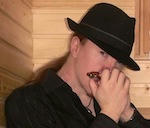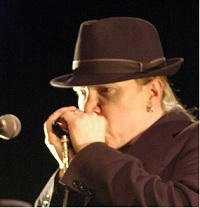apskarp
431 posts
Mar 16, 2011
1:53 AM

|
Here are some notes I made from last weekends gig. In the end of the evening we had the honor to play couple of songs with mr. Pepe Ahlqvist and naturally I moved from lead singer to accompaniment harpist. I don't have much experience on that - I've just really read David Barrett's (excellent) book on the topic and tried to listen some great harpists from records. Knowing the things in theory is of course different to real world. Thus this was a really good learning experience for me. Here are some notes I made after listening the audio track we recorded:
-Put more woodshedding to headshakes, it sounds crap if it's not accurate (and it's harder on stage with adrenaline, bad monitors etc)
-While playing the harp behind the vocals put the mic volume to 50% (not just adjusting the volume by breath control)
-The sound and the volume levels are different to stage and to the audience, thus it is safer to not play the harp at all behind the vocals or guitar solos (you just can't know the volume levels if you haven't played on the venue often with familiar soundman)
-Chords work really well, learn few different chords (perhaps from different harp keys) to play over the bars
-Chords work really well also in the solos
So that's it. Anything to add to that?
PS. I used Zoom H4n to record stereo output straight from the table + Zoom's own condensator mics to pick up the ambient sound. It worked really good, I recommend using some device like that to really get the sounds right from your gigs...
----------

Youtube
Hoodoo Sauna
Blog
|
apskarp
435 posts
Mar 18, 2011
1:10 PM

|
Few more observations:
Actually the volume of the harps wasn't so bad when listened from the handheld camera mics. Apparently the line out from the mixer table put more volume to the harp sound than what was heard in the audience. However, it still is a valid point to make sure your volume is low enough while playing behind vocals / guitar solos.
Another thing I realized was that the gig was very late at night. The jamming began about 1am and I woke up 6.30AM previous morning. We were on the studio for the whole day which meant it was a loooong day... Sitting few hours on a backstage after soundcheck is also pretty hard. Obviously it is harder to remain focused for playing when you are tired - this means that you will do more mistakes than normally. So woodshedding is really important in that sense too. The better your technique and experience, the less the tiredness will affect your playing.
It was amazing to listen how well Pepe Ahlqvist played his parts also in the jamming. It was like listening a record - there was no indication of tiredness in his vocals or guitar playing even though he started the day waking up at 4AM and driving 600km to northern Finland to help us with our recordings. (And he is 20 years older than I am...) It is really amazing, I can only admire his skills and energy.
----------

Youtube
Hoodoo Sauna
Blog
|
Joe_L
1133 posts
Mar 18, 2011
2:45 PM

|
I only started singing a little over a year ago. I've accompanied other players for a long time. Here are my thoughts on your notes. This is purely the opinion of a guy that reads the Internet.
-Put more woodshedding to headshakes, it sounds crap if it's not accurate (and it's harder on stage with adrenaline, bad monitors etc)
Most things sound like crap, if it's not accurate. Headshakes are one thing. There are a lot of different ways to play those things. Little Walter, Big Walter and James Cotton's shakes all sound different. It's a good idea to learn a multitude of different sounds when using that technique.
-While playing the harp behind the vocals put the mic volume to 50% (not just adjusting the volume by breath control)
This is something I almost never do. I tend to set the volume control once and rarely mess with it. I usually adjust my volume with breath control and hand techniques. Usually, I adjust the volume control when I am experiencing feedback.
One other time I mess with it is if I am going to play busy behind the singer. I'll turn the volume control down, so it doesn't overpower the vocalist. I rarely use this technique. I only use it when I know the vocalist and know they trust me.
-The sound and the volume levels are different to stage and to the audience, thus it is safer to not play the harp at all behind the vocals or guitar solos (you just can't know the volume levels if you haven't played on the venue often with familiar soundman)
You should always be aware of your volume. Each room is different. Thankfully, not all rooms have a soundman. I find that few soundmen know how to deal with harp players.
-Chords work really well, learn few different chords (perhaps from different harp keys) to play over the bars
-Chords work really well also in the solos
Chords are super useful. They can add depth to your sound. When playing traditional Blues, they are required. When playing solo, chords help establish the groove. You can also use them to create and release tension, e.g. Junior Wells was a master at that.
- One super important thing that you left out is watch the leader. That requires you to keep your eyes open and don't wear sunglasses unless the sun is shining.
- All singers have vocal patterns. All guitarists have patterns. Be attentive and learn them. React accordingly.
- When accompanying others, find out what they are listening to and who they are influenced by. Listen to those artists. Figure out what fits. Play that. Usually, it'll do you no good to try to play Jason Ricci-style licks when backing a performer that is highly influenced by Tampa Red, Big Broonzy or Robert Johnson.
----------
The Blues Photo Gallery
|
toddlgreene
2754 posts
Mar 18, 2011
3:09 PM

|
Good points. I'll add an additional point to the one I'm pretty sure Joe means with the 'no sunglasses' rule(other than it just doesn't make any sense in a dark room):if you're in a jam situation or not playing with a pre-rehearsed arrangement, try not to always play with your eyes closed-you might miss some signals! There was a guitarist at a jam here the other night who was in his own world, just jamming away, and he was totally oblivious to the fact that I was hand signalling to end a song-I finally had to tap him on the shoulder to get his attention.
----------
Todd
Eudora and Deep Soul
Last Edited by on Mar 18, 2011 3:10 PM
|
Joe_L
1134 posts
Mar 18, 2011
9:58 PM

|
Todd - that's exactly what I've met. Watch the leader. Pay attention. Sunglasses or playing with your eyes closed or covered prohibits that. The music should take precedence over image.
----------
The Blues Photo Gallery
|
apskarp
436 posts
Mar 18, 2011
11:27 PM

|
Good additions Joe. Actually I do watch the leader intensely while backing him/her, it's quite natural thing to do and it also creates a feeling to the audience that those guys are really working/talking together.
One thing I left wondering after last weekend is the monitoring. It was impossible to get good monitoring to the stage, which made it really hard to play the harp. Sometimes I didn't hear whether I was blowing the right hole at all!
Do you guys have any tips for those situations?
----------

Youtube
Hoodoo Sauna
Blog
|
Joe_L
1135 posts
Mar 19, 2011
4:09 AM

|
Yes. Unfortunately, you're kind of screwed. You need to learn and practice some soloes that can repeat at will. You don't need a lot of them. You're playing may seem repetitive to you. Most of the time, the audience won't care. If you've ever seen Muddy Waters play guitar later in life, you'll know that he played one or two guitar soloes. Very few people complained.
Some of Junior Wells' harp playing was repetitive, too. He had about four or five soloes that he knew stoned cold. Same thing with James Cotton in his later years. I've seen James Cotton and Rick Estrin play the same lick through an entire solo. Learn one of those and you've got it made.
Learn what you do well and play to those strengths.
People played Blues to avoid hard labor. Your playing doesn't have to be complex to be effective.
This is why it's helpful to have a large amp or to be able to play through the PA.
----------
The Blues Photo Gallery
|
apskarp
437 posts
Mar 19, 2011
6:57 AM

|
That's a good advice Joe!
Actually one problem I have is that I get bored really easily. If I'll be playing same kind of licks for awhile I feel like I MUST alternate it somehow. But the truth is that if somethings works well, there's really no reason to fix it. Most of the audience aren't harp players (except in SPAH f.ex.) and they aren't really paying so much attention on what kind of licks the harpist is playing and how much he alters them. They are listening to the song as a whole and perhaps the vocals and the words if they are any good.
This is definitely something I must pay more attention to. Learn few good solo's and licks that you can play blindfolded even if you don't hear the harp yourself. The same with the chords & accompaniment rhythms. And don't worry about overusing them. Keep it simple.
Thank's! :)
----------

Youtube
Hoodoo Sauna
Blog
|
Shredder
245 posts
Mar 19, 2011
8:59 AM

|
@ apskarp
I know they cost a lot but in ear monitors solved my not being able to hear my self problems, running thru the PA also helps. My band solved the problem and canned the old FOH method and went with a Bose L1-model 2 PA system. What you hear is what the audince hears so there is no more guessing if your playing over the vocals or just blending in. The speakers are located behind the band. It takes some getting used to but once you under stand how things work it's great.
Get on the Bose web site and watch the video of how the system works. We started with one unit and 4 players running thru it. We just recived a 2nd unit yesterday and should not ever need any thing more.
On another note. I have been using a Morley volume plus pedal for 2 months now and like it.When activated you can set a minimum volume level for playing in the back ground. When it comes time for a lead push the pedal forward for full volume. It takes the guess work out of "did I come back to the same volume I was at before the lead break" issue.
Hope this helps.
Just to clarify, every one runs"line outs" thru the Bose. You can put your amps off stage if need be.
Mike
Last Edited by on Mar 19, 2011 9:01 AM
|
apskarp
438 posts
Mar 20, 2011
8:12 AM

|
In-ear monitors would be cool. I have actually thought about that - I have good custom ear plugins from Elacin that could be updated with earphone plugins. In ear monitoring could be added to that.
However, as this is just a hobby it wouldn't be reasonable to put thousands of dollars for monitoring equipment - we do just a few gig in a year. But do you guys have any experience on the cheaper systems?
----------

Youtube
Hoodoo Sauna
Blog
|